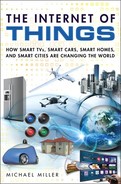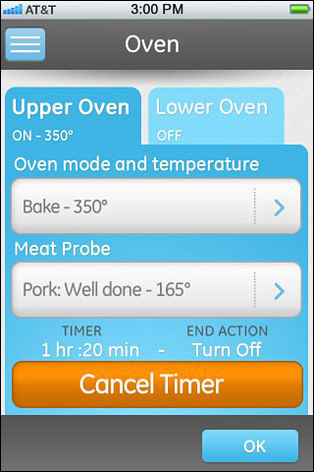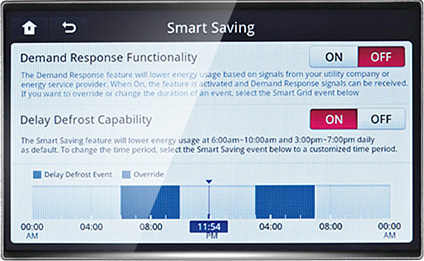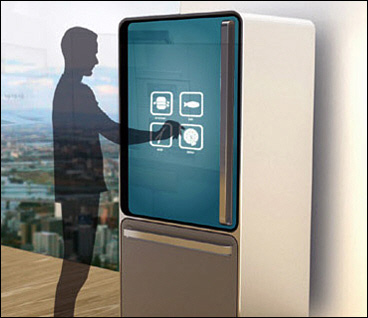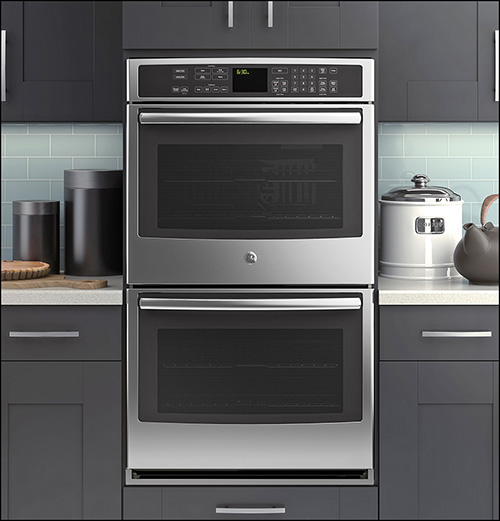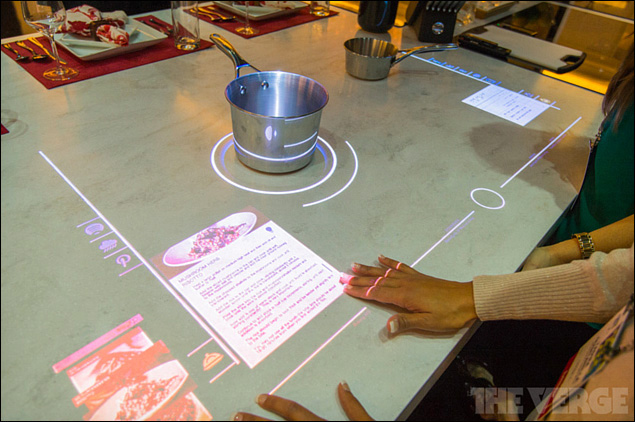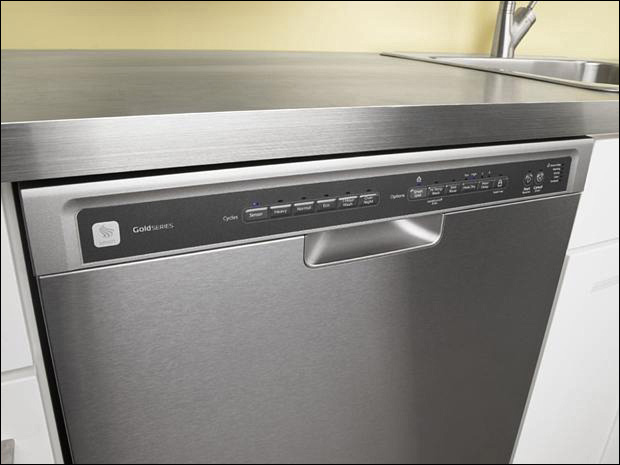4. Smart Appliances: From Remote Control Ovens to Talking Refrigerators
Smart appliances represent a large potential part of the Internet of Things. In the future, smart refrigerators might monitor food usage, and text or email you detailed shopping lists; smart ovens will know what you’re cooking and when you eat, and turn themselves on automatically; and smart laundry machines will run when you’re away from home and won’t hear the noise. But there’s a lot more to smart appliances than just Internet-connected dishwashers and intelligent toasters, as you’ll soon see.
Understanding Smart Appliances Today
There’s nothing quite so dumb as those big metal boxes taking up space in your kitchen. Your refrigerator is just a big insulated box designed to keep food cool. Your dishwasher has only enough brains to start the designated cycle at the time you set beforehand. Your oven has a timer, too, but you have to manually set the desired temperature. Your microwave oven is a little smarter, in that it has a few preprogrammed power levels for specific types of food, but the clock doesn’t know enough to reset itself for Daylight Saving Time. And while your washer and dryer include some preprogrammed cycles for different types of fabrics, and the dryer maybe even has a moisture sensor to tell you when everything’s properly dry, both are still simple machines, waiting for you to tell them what to do.
And that’s the state of smart appliances as of a year or two ago: lots of appliances, not a lot of smarts.
As you’ve probably suspected by now, the use of the term “smart” is as much a marketing ploy as it is a true descriptor for anything connected to the Internet of Things. Different companies define smart in different ways, as do different industries. A smart TV might be more or less intelligent than a smart water softener or smart car, but they’re all equally smart in the eyes of the marketing guys.
So what does it mean when we call an appliance “smart”? It all has to do with automating routine operations.
Smart Operation
The first thing that many will find smart about smart appliances is the ability to manage them remotely. We’re used to setting a timer or a given start time to fire up the oven or activate the dishwasher; this sort of timed start is useful for starting dinner before you get home from work, or running water-intensive appliances later at night when nobody’s taking a shower.
With smart appliances, this automatic operation gets more flexible. Instead of manually setting a timer on the front panel of a device, you can use an app on your smartphone or tablet to remotely press the start button on a given appliance. Some apps even let you program operations in advance—like setting a manual timer, but more sophisticated.
For example, General Electric’s (GE’s) Brillion smartphone app, shown in Figure 4.1, offers remote operation of select wall ovens. You can be miles away at work, with a big pan filled with a roast in the oven (you put it there before you left in the morning), and all you have to do is tap the app to start up the oven and start cooking. Or maybe you want to preheat your oven to a certain temperature for use when you get home. In any case, it’s easy-as-pie remote operation, all thanks to a convenient mobile app and Internet connectivity.
Even better is LG’s new HomeChat app, which lets you send text messages to your appliances just as if they were human. (HomeChat operates via the popular LINE messaging app.) As you can see in Figure 4.2, you use text messages to send commands to your appliances in plain English—and receive messages from them via text, as well. Right now, you can text basic operation commands, but you may eventually be able to text your fridge, “Is the milk fresh?” and receive an answer in return.
Smart Monitoring
For a smart appliance to be truly smart, it must monitor its environment and operation to let you know about things you need to know about. That means sending out some sort of alert or notification when a given operation is done or when something unexpected happens.
Today, appliances typically alert you with a loud buzzer or rinky-dink snippet of music. (I absolutely hate the notification music from our LG laundry equipment!) Smarter appliances will send out smarter notifications.
For example, a smart washer might send a notification to its corresponding smartphone app when the washing cycle is complete. Or maybe you’ll get a text message notifying you that your dinner is finished cooking in your smart oven. Or how about an email alert if somebody leaves the refrigerator door open?
The key is to use connected technology to notify you of important stuff happening in the kitchen or laundry room. We have the technology; we can do this.
For example, Whirlpool’s My Smart Appliances app, shown in Figure 4.3, lets you monitor the status of all your appliances on your smartphone screen. You can see how much time is remaining for your loads, get notified when a washing or drying cycle is complete, or see how cool your refrigerator is today. It’s a lot better than hanging around the laundry room waiting for the buzzer to sound.
Smart Energy Savings
Some of today’s smart appliances use their smarts to cut down on energy usage. If an appliance knows when power consumption is lower or rates are cheaper, it can program itself to operate during those times. In addition, smart appliances typically include other energy-efficient functionality, such as a dishwasher using less water per cycle or a refrigerator incorporating more insulation to keep things frosty.
For example, LG’s Smart Grid technology detects when local power consumption is lowest and schedules more operations during that time. Figure 4.4 shows one of the Smart Grid configuration screens. (Note that this feature is only available to those homes served by a Smart Grid power company.)
A Smart Grid is a new type of electrical power grid that incorporates built-in intelligence and digital communications technology. Learn more in Chapter 13, “Smart Cities: Everyone’s Connected.”
Smart Maintenance
Then there’s the process of keeping your smart appliance up to date and in tip-top operating condition. This involves having the right sensors within each appliance to determine when some maintenance needs to be done or when some function isn’t properly functioning. Then, instead of just flashing a light on the appliance’s front panel, you get notified (via app, text message, or email) about the issue at hand. Ideally, the message includes advice or instructions for what you should do next.
For example, you’re probably used to seeing an alert light above your refrigerator’s water dispenser when the water filter needs to be changed. With a smarter refrigerator, you’d get a text message or email to that effect instead. Same thing when you need to add more fabric conditioner to your smart dryer, or if the hot water in your dishwasher isn’t getting hot enough.
It’s all about smart diagnostics and alerts making you more aware of things you need to be aware of—and aiding in the diagnosis when things go wrong. For example, LG’s Smart Diagnosis app, shown in Figure 4.5, helps you troubleshoot issues by transmitting relevant data over Wi-Fi to the related smartphone app. This data can then be passed on to LG’s Call Center for their technicians to analyze. It certainly reduces the guesswork.
Smarter Food Storage with Smart Refrigerators
Initial smart refrigerators were simply fridges with liquid crystal display (LCD) screens in the door. That’s nice, especially if the screen (and the fridge) are connected to the Internet, so you can do your web browsing (for recipes, let’s say) or watch Netflix while you’re cooking. But the extra cost associated with this feature made these models price-prohibitive; you could get the same functionality with a $200 Android tablet.
That’s starting to change and will change even more in the months and years to come. We’re talking about true added functionality—especially as your smart refrigerator starts to connect to other appliances in the kitchen.
First, the basic stuff. A smart refrigerator should be able to monitor its own performance and keep itself at the proper temperature for the food inside. If the temperature changes, it should notify you before your food goes bad.
It’s also nice if the smart fridge “nudges” you to do certain things in certain situations. How about a text message or alert from the smart appliance app when someone leaves the refrigerator door open? Or when the filter for the in-door water dispenser needs to be replaced?
Beyond that, how about a refrigerator that lets you know when foods expire? Or one that knows what foods you like and monitors its own inventory? Even better, the smart fridge should know when you’re low on your favorite foods and beverages, and use that information to assemble a grocery list. Even better than that, the fridge should then send (via text or email or whatever) the grocery list to your local grocery store, which then fills the order and delivers those groceries to the door—and sends an electronic invoice for the goods purchased. (You’ll still have to manually stock the groceries in the fridge, however, unless someone invents a handy dandy robot to do that chore.)
This communication doesn’t have to be all high tech, either. If you’re there in the kitchen, why not have your refrigerator tell you (in one of those politely clipped British accents, probably) that you forgot to close the door, or that it’s time to preheat the oven, or that you’re out of mustard? Maybe all this smart stuff will be more palatable if it comes with the right accent.
Connect your smart TV to other devices in your home and things get even more interesting. Imagine that you’re watching your favorite cooking show on the Food Network and see a recipe you like. You use your smart TV to save the recipe and send it to your smart refrigerator. The fridge stores the recipe and determines whether or not you have all the ingredients necessary. If you don’t, it either tells you what you need or automatically adds those items to the next grocery list. And all this happens before the show you’re watching goes to commercial.
Even better, why not let your smart fridge figure out what to cook, based on what ingredients you have on hand? Using a combination of sensors and internal cameras, your refrigerator will know what’s inside and use its own built-in intelligence (matched to a database of recipes, of course) to figure what you can cook, based on how well stocked it is. Takes all the guesswork out of meal planning.
Within the kitchen, connect your smart refrigerator to your smart range to make cooking easier. Send a recipe from your smart refrigerator to your smart range to automatically set the precise cooking time and temperature, and then get alerted when it’s time to start cooking.
What about using a smart fridge to help you diet? Connect your refrigerator to your smart scale or fitness band and it’ll know what foods you should be avoiding. Imagine your smart refrigerator nagging you not to eat that pint of ice cream or slice of pie as you start to take it out of the fridge. Annoying, perhaps, but also nudging you toward a healthier lifestyle. (Or maybe the fridge is so Draconian it refuses to stock unhealthy items? It’s possible.)
If your smart refrigerator has a built-in LCD touchscreen (and it probably does), then you can use that touchscreen for all manner of applications. You can view the daily weather report, read the latest news, even watch your favorite TV morning show. You can also use the screen to display a slideshow of family pictures or the built-in speakers to listen to music via Pandora or Spotify. And, of course, surf the web for the latest recipes and cooking tips.
Once you start thinking outside the (ice) box, the sky’s the limit. Ashley Legg of Yanko Design envisions a Smart Fridge where the entire refrigerator door, when closed, becomes a touchscreen interface, thanks to electrochromic window technology. Essentially, you have a glass door that becomes opaque at the touch of a button; combined with touch sensor technology, you get a large operating interface, as shown in Figure 4.6. You can then use the touch interface to display menus, ingredient lists, step-by-step instructions—you name it.
But that’s the future. Today’s smart refrigerators incorporate self-diagnostics, “smart” cooling (setting different temperatures for different areas of the fridge), and some type of touchscreen display. The bigger displays function like embedded tablets, with full Internet connectivity. But there’s not a lot of smart connectivity as yet; that functionality is still to come.
![]() Note
Note
Because of the combination of high price and limited functionality, smart refrigerators (sometimes called Internet refrigerators) have not seen much success in the marketplace. Whirlpool recently discontinued their lone smart refrigerator model, and LG dropped their entire line of ThinQ smart appliances. I expect all these companies to keep plugging at the smart appliance market, but it’s going to take more than a fancy touchscreen to pique consumers’ attention.
Smarter Cooking with Smart Ovens
There’s a world of possibilities when you add just a little intelligence to your oven and cooktop. It’s all a matter of trying to make cooking easier—and more accurate.
First, there’s the simple matter of monitoring cooking temperature. Put a temperature probe or temperature/humidity sensors in the smart oven, and you can be alerted (via smartphone app) when your casserole or turkey reaches the correct temperature. Or with a little predictive intelligence, you get an alert when the meal is 10 minutes away from being done, so you’ll have time to set the table.
Of course, if you have that range app on your smartphone or tablet, you can use it to start up your oven or cooktop and dial in the correct cooking temperature. This will let you warm up your oven or even start cooking while you’re still at work or sitting in rush hour traffic on the way home. (Figure 4.7 shows a GE double convection wall oven with built-in Brillion smart operation.)
Looking beyond that, there’s a lot more you can do if you connect your range to your refrigerator or even to a smartphone recipe app. The most obvious application is to select a recipe on your phone or on the smart fridge, and then have your oven automatically set itself for the correct cooking temperature and time.
And then there’s Whirlpool’s touchscreen cooktop prototype, shown in Figure 4.8. This one’s kind of cool, as it melds a touchscreen display with a glass induction cooktop. The surface stays cool to the touch, as the induction heating elements only interact with metal pots and pans. Display your recipes or other info on the cooktop itself and control things with a swipe of your fingers.
Smarter Cleaning with Smart Washers and Dryers
How smart do a washer and dryer need to be? All they do is wash and dry clothes, right? Well, there’s a lot you can automate about your laundry operation—and become more efficient, to boot.
First off, the smarter the equipment is, the better it can wash and dry your clothes. Moisture sensors in both washers and dryers can help fine tune wash and dry cycles based on the clothing being laundered. Automatic sensing of fabric type can help the washer set the correct wash cycle and the dryer adjust the heat accordingly.
Of course, there’s always remote control operation. Use your smartphone app to start your washer remotely, even when you’re not at home. You can also use the smartphone app to monitor your laundry’s progress and get notified when the load is done.
And don’t forget energy usage. A smart washer will know when’s the best time to operate based on water usage and rates, and the dryer will know the same based on electric rates. Smarter operation will reduce your energy costs.
Connect your washer and dryer together and the process gets even more efficient. For example, select GE laundry equipment, such as the washer in Figure 4.9, uses CleanSpeak technology to pass information from washer to dryer concerning how much moisture is left in the clothes. The dryer can then adjust the drying cycle accordingly.
Whirlpool takes this smart business a step further with its Smart Front Load Washer and Dryer that don’t connect to each other, but rather to the Nest Learning Thermostat. The Nest thermostat is a smart thermostat that knows when homeowners are away and feeds that information to the Whirlpool laundry pair. The washer and dryer then switch to lower-power operating modes to save energy. Expect more smart appliances to interface with smart thermostats and other smart devices, especially when energy savings can result.
Smarter Dishwashing with Smart Dishwashers
Most of the functionality possible in smart washers is also possible in smart dishwashers. You can operate the dishwasher remotely via a smartphone app and be notified when a load is complete. In addition, you can remotely lock the dishwasher, to ensure that your kids won’t be playing in it when you’re not there. (The Whirlpool dishwasher shown in Figure 4.10 features this type of remote operation.)
In addition, the smart dishwasher will know when the best time is to operate, based not only on water and electrical usage and rates (when connected to a Smart Grid), but also on when the house needs to be quiet, when the tub is filling up, and when you need those dishes for the next meal. Ideally, it will also determine what type of cycle to use, by sensing the types of dishes and pots and pans inside, and how dirty they are.
